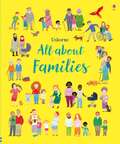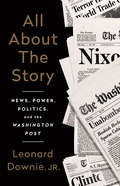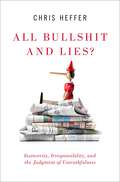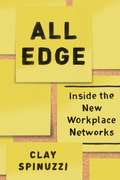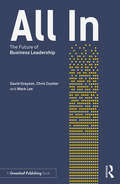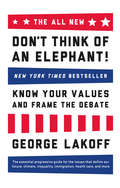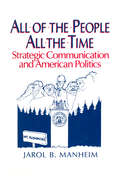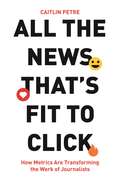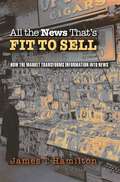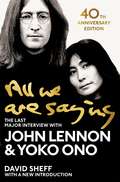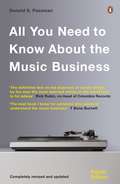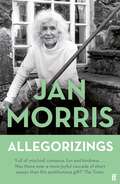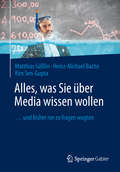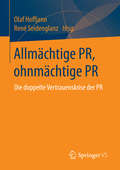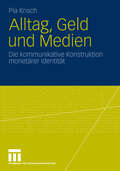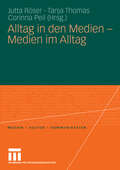- Table View
- List View
All About Families (All About)
by Felicity BrooksA entertaining and gently informative book that potrays diverse families and helps children think, talk about and understand difference.
All About the Story: News, Power, Politics, and the Washington Post
by Leonard Downie JrAt a time when the role of journalism is especially critical, the former executive editor of the Washington Post writes about his nearly 50 years at the newspaper and the importance of getting at the truth. In 1964, as a 22-year-old Ohio State graduate with working-class Cleveland roots and a family to support, Len Downie landed an internship with the Washington Post. He would become a pioneering investigative reporter, news editor, foreign correspondent, and managing editor, before succeeding the legendary Ben Bradlee as executive editor. Downie's leadership style differed from Bradlee's, but he played an equally important role over more than four decades in making the Post one of the world's leading news organizations. He was one of the editors on the historic Watergate story and drove coverage of the impeachment of President Bill Clinton. He wrestled with the Unabomber's threat to kill more people unless the Post published a rambling 30,000-word manifesto and he published important national security stories in defiance of presidents and top officials. He managed the Post's ascendency to the pinnacle of influence, circulation, and profitability, producing prizewinning investigative reporting with deep impact on American life, before the digital transformation of news media threatened the Post's future.At a dangerous time, when health and economic crises and partisanship are challenging the news media, Downie's judgment, fairness, and commitment to truth will inspire anyone who wants to know how journalism, at its best, works.
All Bullshit and Lies?: Insincerity, Irresponsibility, and the Judgment of Untruthfulness
by Chris HefferIn a postfactual world in which claims are often held to be true only to the extent that they confirm pre-existing or partisan beliefs, this book asks crucial questions: how can we identify the many forms of untruthfulness in discourse? How can we know when their use is ethically wrong? How can we judge untruthfulness in the messiness of situated discourse? Drawing on pragmatics, philosophy, psychology, and law, All Bullshit and Lies? develops a comprehensive framework for analyzing untruthful discourse in situated context. TRUST, or Trust-related Untruthfulness in Situated Text, sees untruthfulness as encompassing not only deliberate manipulations of what is believed to be true (the insincerity of withholding, misleading, and lying) but also the distortions that arise from an irresponsible attitude towards the truth (dogma, distortion, and bullshit). Chris Heffer discusses times when truth is not "in play," as in jokes or fiction, as well as instances when concealing the truth can achieve a greater good. The TRUST framework demonstrates that untruthfulness becomes unethical in discourse, though, when it unjustifiably breaches the trust an interlocutor invests in the speaker. In addition to the theoretical framework, this book provides a clear, practical heuristic for analyzing discursive untruthfulness and applies it to such cases of public discourse as the Brexit "battle bus," Trump's tweet about voter fraud, Blair and Bush's claims about weapons of mass destruction, and the multiple forms of untruthfulness associated with the Skripal poisoning case. In All Bullshit and Lies? Chris Heffer turns a critical eye to fundamental questions of truthfulness and trust in our society. This timely and interdisciplinary investigation of discourse provides readers a deeper theoretical understanding of untruthfulness in a postfactual world.
ALL BULLSHIT & LIES? C: Insincerity, Irresponsibility, and the Judgment of Untruthfulness
by Chris HefferIn a postfactual world in which claims are often held to be true only to the extent that they confirm pre-existing or partisan beliefs, this book asks crucial questions: how can we identify the many forms of untruthfulness in discourse? How can we know when their use is ethically wrong? How can we judge untruthfulness in the messiness of situated discourse? Drawing on pragmatics, philosophy, psychology, and law, All Bullshit and Lies? develops a comprehensive framework for analyzing untruthful discourse in situated context. TRUST, or Trust-related Untruthfulness in Situated Text, sees untruthfulness as encompassing not only deliberate manipulations of what is believed to be true (the insincerity of withholding, misleading, and lying) but also the distortions that arise from an irresponsible attitude towards the truth (dogma, distortion, and bullshit). Chris Heffer discusses times when truth is not "in play," as in jokes or fiction, as well as instances when concealing the truth can achieve a greater good. The TRUST framework demonstrates that untruthfulness becomes unethical in discourse, though, when it unjustifiably breaches the trust an interlocutor invests in the speaker. In addition to the theoretical framework, this book provides a clear, practical heuristic for analyzing discursive untruthfulness and applies it to such cases of public discourse as the Brexit "battle bus," Trump's tweet about voter fraud, Blair and Bush's claims about weapons of mass destruction, and the multiple forms of untruthfulness associated with the Skripal poisoning case. In All Bullshit and Lies? Chris Heffer turns a critical eye to fundamental questions of truthfulness and trust in our society. This timely and interdisciplinary investigation of discourse provides readers a deeper theoretical understanding of untruthfulness in a postfactual world.
All Edge: Inside the New Workplace Networks
by Clay SpinuzziWork is changing. Speed and flexibility are more in demand than ever before thanks to an accelerating knowledge economy and sophisticated communication networks. These changes have forced a mass rethinking of the way we coordinate, collaborate, and communicate. Instead of projects coming to established teams, teams are increasingly converging around projects. These “all-edge adhocracies” are highly collaborative and mostly temporary, their edge coming from the ability to form links both inside and outside an organization. These nimble groups come together around a specific task, recruiting personnel, assigning roles, and establishing objectives. When the work is done they disband their members and take their skills to the next project. Spinuzzi offers for the first time a comprehensive framework for understanding how these new groups function and thrive. His rigorous analysis tackles both the pros and cons of this evolving workflow and is based in case studies of real all-edge adhocracies at work. His provocative results will challenge our long-held assumptions about how we should be doing work.
All Edge: Inside the New Workplace Networks
by Clay SpinuzziWork is changing. Speed and flexibility are more in demand than ever before thanks to an accelerating knowledge economy and sophisticated communication networks. These changes have forced a mass rethinking of the way we coordinate, collaborate, and communicate. Instead of projects coming to established teams, teams are increasingly converging around projects. These “all-edge adhocracies” are highly collaborative and mostly temporary, their edge coming from the ability to form links both inside and outside an organization. These nimble groups come together around a specific task, recruiting personnel, assigning roles, and establishing objectives. When the work is done they disband their members and take their skills to the next project. Spinuzzi offers for the first time a comprehensive framework for understanding how these new groups function and thrive. His rigorous analysis tackles both the pros and cons of this evolving workflow and is based in case studies of real all-edge adhocracies at work. His provocative results will challenge our long-held assumptions about how we should be doing work.
All Edge: Inside the New Workplace Networks
by Clay SpinuzziWork is changing. Speed and flexibility are more in demand than ever before thanks to an accelerating knowledge economy and sophisticated communication networks. These changes have forced a mass rethinking of the way we coordinate, collaborate, and communicate. Instead of projects coming to established teams, teams are increasingly converging around projects. These “all-edge adhocracies” are highly collaborative and mostly temporary, their edge coming from the ability to form links both inside and outside an organization. These nimble groups come together around a specific task, recruiting personnel, assigning roles, and establishing objectives. When the work is done they disband their members and take their skills to the next project. Spinuzzi offers for the first time a comprehensive framework for understanding how these new groups function and thrive. His rigorous analysis tackles both the pros and cons of this evolving workflow and is based in case studies of real all-edge adhocracies at work. His provocative results will challenge our long-held assumptions about how we should be doing work.
All Edge: Inside the New Workplace Networks
by Clay SpinuzziWork is changing. Speed and flexibility are more in demand than ever before thanks to an accelerating knowledge economy and sophisticated communication networks. These changes have forced a mass rethinking of the way we coordinate, collaborate, and communicate. Instead of projects coming to established teams, teams are increasingly converging around projects. These “all-edge adhocracies” are highly collaborative and mostly temporary, their edge coming from the ability to form links both inside and outside an organization. These nimble groups come together around a specific task, recruiting personnel, assigning roles, and establishing objectives. When the work is done they disband their members and take their skills to the next project. Spinuzzi offers for the first time a comprehensive framework for understanding how these new groups function and thrive. His rigorous analysis tackles both the pros and cons of this evolving workflow and is based in case studies of real all-edge adhocracies at work. His provocative results will challenge our long-held assumptions about how we should be doing work.
All In: The Future of Business Leadership
by David Grayson Chris Coulter Mark LeeWritten by three leading thinkers in the field of sustainability, All In defines the essential attributes of high-impact corporate sustainability leadership and describes how companies can combine and apply those characteristics for future success. All In draws on research involving thousands of experts globally as collected via the GlobeScan-SustainAbility Leaders Survey over two decades. The book also reveals insights from dozens of interviews with Chairs, CEOs and Chief Sustainability Officers of pioneering companies, including 3M, BASF, BP, DuPont, Google, GE, Huawei, IKEA, Interface, Marks & Spencer, Natura, Nestlé, Nike, Novo Nordisk, Patagonia, Shell, Tata, Toyota, Unilever and Walmart, explaining how they have gained recognition, created value and boosted resiliency based on their sustainability leadership. All In also outlines what the private sector must do to lift sustainability performance, protect business’s license to operate and help deliver the UN Sustainable Development Goals by 2030. This unique book, rich with quantitative and qualitative insights, offers current and aspiring business leaders a succinct overview of the most important developments and trends in corporate sustainability and responsible leadership. All In will also appeal to others interested in why sustainability has become a critical mainstream business issue. With a foreword by Dan Hendrix, Chairman, Interface, and afterword by Paul Polman, CEO, Unilever.
All In: The Future of Business Leadership
by David Grayson Chris Coulter Mark LeeWritten by three leading thinkers in the field of sustainability, All In defines the essential attributes of high-impact corporate sustainability leadership and describes how companies can combine and apply those characteristics for future success. All In draws on research involving thousands of experts globally as collected via the GlobeScan-SustainAbility Leaders Survey over two decades. The book also reveals insights from dozens of interviews with Chairs, CEOs and Chief Sustainability Officers of pioneering companies, including 3M, BASF, BP, DuPont, Google, GE, Huawei, IKEA, Interface, Marks & Spencer, Natura, Nestlé, Nike, Novo Nordisk, Patagonia, Shell, Tata, Toyota, Unilever and Walmart, explaining how they have gained recognition, created value and boosted resiliency based on their sustainability leadership. All In also outlines what the private sector must do to lift sustainability performance, protect business’s license to operate and help deliver the UN Sustainable Development Goals by 2030. This unique book, rich with quantitative and qualitative insights, offers current and aspiring business leaders a succinct overview of the most important developments and trends in corporate sustainability and responsible leadership. All In will also appeal to others interested in why sustainability has become a critical mainstream business issue. With a foreword by Dan Hendrix, Chairman, Interface, and afterword by Paul Polman, CEO, Unilever.
The ALL NEW Don't Think of an Elephant!: Know Your Values and Frame the Debate
by George LakoffTen years after writing the definitive, international bestselling book on political debate and messaging, George Lakoff returns with new strategies about how to frame today’s essential issues. Called the “father of framing” by The New York Times, Lakoff explains how framing is about ideas—ideas that come before policy, ideas that make sense of facts, ideas that are proactive not reactive, positive not negative, ideas that need to be communicated out loud every day in public. The ALL NEW Don’t Think of an Elephant! picks up where the original book left off—delving deeper into how framing works, how framing has evolved in the past decade, how to speak to people who harbor elements of both progressive and conservative worldviews, how to counter propaganda and slogans, and more. In this updated and expanded edition, Lakoff, urges progressives to go beyond the typical laundry list of facts, policies, and programs and present a clear moral vision to the country—one that is traditionally American and can become a guidepost for developing compassionate, effective policy that upholds citizens’ well-being and freedom.
All of the People, All of the Time: Strategic Communication and American Politics
by Jarol B. ManheimThis book is about the uses and abuses of political communication in contemporary American society, employing numerous anecdotes and examples and drawings upon the latest research and theories of communication and political science in America.
All of the People, All of the Time: Strategic Communication and American Politics
by Jarol B. ManheimThis book is about the uses and abuses of political communication in contemporary American society, employing numerous anecdotes and examples and drawings upon the latest research and theories of communication and political science in America.
All the News That’s Fit to Click: How Metrics Are Transforming the Work of Journalists
by Caitlin PetreFrom the New York Times to Gawker, a behind-the-scenes look at how performance analytics are transforming journalism today—and how they might remake other professions tomorrowJournalists today are inundated with data about which stories attract the most clicks, likes, comments, and shares. These metrics influence what stories are written, how news is promoted, and even which journalists get hired and fired. Do metrics make journalists more accountable to the public? Or are these data tools the contemporary equivalent of a stopwatch wielded by a factory boss, worsening newsroom working conditions and journalism quality? In All the News That's Fit to Click, Caitlin Petre takes readers behind the scenes at the New York Times, Gawker, and the prominent news analytics company Chartbeat to explore how performance metrics are transforming the work of journalism.Petre describes how digital metrics are a powerful but insidious new form of managerial surveillance and discipline. Real-time analytics tools are designed to win the trust and loyalty of wary journalists by mimicking key features of addictive games, including immersive displays, instant feedback, and constantly updated “scores” and rankings. Many journalists get hooked on metrics—and pressure themselves to work ever harder to boost their numbers.Yet this is not a simple story of managerial domination. Contrary to the typical perception of metrics as inevitably disempowering, Petre shows how some journalists leverage metrics to their advantage, using them to advocate for their professional worth and autonomy.An eye-opening account of data-driven journalism, All the News That's Fit to Click is also an important preview of how the metrics revolution may transform other professions.
All the News That’s Fit to Click: How Metrics Are Transforming the Work of Journalists
by Caitlin PetreFrom the New York Times to Gawker, a behind-the-scenes look at how performance analytics are transforming journalism today—and how they might remake other professions tomorrowJournalists today are inundated with data about which stories attract the most clicks, likes, comments, and shares. These metrics influence what stories are written, how news is promoted, and even which journalists get hired and fired. Do metrics make journalists more accountable to the public? Or are these data tools the contemporary equivalent of a stopwatch wielded by a factory boss, worsening newsroom working conditions and journalism quality? In All the News That's Fit to Click, Caitlin Petre takes readers behind the scenes at the New York Times, Gawker, and the prominent news analytics company Chartbeat to explore how performance metrics are transforming the work of journalism.Petre describes how digital metrics are a powerful but insidious new form of managerial surveillance and discipline. Real-time analytics tools are designed to win the trust and loyalty of wary journalists by mimicking key features of addictive games, including immersive displays, instant feedback, and constantly updated “scores” and rankings. Many journalists get hooked on metrics—and pressure themselves to work ever harder to boost their numbers.Yet this is not a simple story of managerial domination. Contrary to the typical perception of metrics as inevitably disempowering, Petre shows how some journalists leverage metrics to their advantage, using them to advocate for their professional worth and autonomy.An eye-opening account of data-driven journalism, All the News That's Fit to Click is also an important preview of how the metrics revolution may transform other professions.
All the News That’s Fit to Sell: How the Market Transforms Information into News
by James T. HamiltonThat market forces drive the news is not news. Whether a story appears in print, on television, or on the Internet depends on who is interested, its value to advertisers, the costs of assembling the details, and competitors' products. But in All the News That's Fit to Sell, economist James Hamilton shows just how this happens. Furthermore, many complaints about journalism--media bias, soft news, and pundits as celebrities--arise from the impact of this economic logic on news judgments. This is the first book to develop an economic theory of news, analyze evidence across a wide range of media markets on how incentives affect news content, and offer policy conclusions. Media bias, for instance, was long a staple of the news. Hamilton's analysis of newspapers from 1870 to 1900 reveals how nonpartisan reporting became the norm. A hundred years later, some partisan elements reemerged as, for example, evening news broadcasts tried to retain young female viewers with stories aimed at their (Democratic) political interests. Examination of story selection on the network evening news programs from 1969 to 1998 shows how cable competition, deregulation, and ownership changes encouraged a shift from hard news about politics toward more soft news about entertainers. Hamilton concludes by calling for lower costs of access to government information, a greater role for nonprofits in funding journalism, the development of norms that stress hard news reporting, and the defining of digital and Internet property rights to encourage the flow of news. Ultimately, this book shows that by more fully understanding the economics behind the news, we will be better positioned to ensure that the news serves the public good.
All the News That’s Fit to Sell: How the Market Transforms Information into News (PDF)
by James T. HamiltonThat market forces drive the news is not news. Whether a story appears in print, on television, or on the Internet depends on who is interested, its value to advertisers, the costs of assembling the details, and competitors' products. But in All the News That's Fit to Sell, economist James Hamilton shows just how this happens. Furthermore, many complaints about journalism--media bias, soft news, and pundits as celebrities--arise from the impact of this economic logic on news judgments. This is the first book to develop an economic theory of news, analyze evidence across a wide range of media markets on how incentives affect news content, and offer policy conclusions. Media bias, for instance, was long a staple of the news. Hamilton's analysis of newspapers from 1870 to 1900 reveals how nonpartisan reporting became the norm. A hundred years later, some partisan elements reemerged as, for example, evening news broadcasts tried to retain young female viewers with stories aimed at their (Democratic) political interests. Examination of story selection on the network evening news programs from 1969 to 1998 shows how cable competition, deregulation, and ownership changes encouraged a shift from hard news about politics toward more soft news about entertainers. Hamilton concludes by calling for lower costs of access to government information, a greater role for nonprofits in funding journalism, the development of norms that stress hard news reporting, and the defining of digital and Internet property rights to encourage the flow of news. Ultimately, this book shows that by more fully understanding the economics behind the news, we will be better positioned to ensure that the news serves the public good.
All We Are Saying: The Last Major Interview with John Lennon and Yoko Ono
by John Lennon Yoko Ono David SheffThe last major interview with John Lennon and Yoko Ono, conducted by New York Times bestselling author David Sheff, featuring a new introduction that reflects on the fortieth anniversary of Lennon's death.Originally published in Playboy in 1981 just after John Lennon's assassination, All We Are Saying is a rich, vivid, complete interview with Lennon and Yoko Ono, covering art, creativity, the music business, childhood beginnings, privacy, how the Beatles broke up, how Lennon and McCartney collaborated (or didn't) on songs, parenthood, money, feminism, religion, and insecurity. Of course, at the heart of the conversation is the deep romantic and spiritual bond between Lennon and Ono.Sheff's insightful questions set the tone for Lennon's responses and his presence sets the scene, as he goes through the kitchen door of Lennon and Yoko's apartment in the Dakota and observes moments at Lennon's famous white piano and the rock star's work at the stove, making them grilled cheese sandwiches. Sheff's new introduction looks at his forty-year-old interview afresh, and examines how what he learned from Lennon has resonated with him as a man and a parent. This is a knockout interview: unguarded, wide-ranging, alternately frisky and intense.
All You Need to Know About the Music Business: Eighth Edition
by Donald S PassmanAll You Need To Know About The Music Business - The new edition of 'the industry bible' (Los Angeles Times) by Donald S. PassmanNo one understands the music business and the changes it has undergone in recent years better than LA lawyer Donald Passman. For 20 years his book has offered detailed advice to artists and executives, novices and experts alike on how to thrive in these volatile times.This completely revised edition sets out recent developments in record deals, copyright, new technologies and film music. It also offers unique advice on how to navigate your way through the ins and outs of songwriting, music publishing, merchandising and performing. Whether you're a newcomer or an established professional, All You Need to Know about the Music Business is an essential companion. It will also be loved by readers of The Music Business and How Music Works by David Byrne.'The definitive text on the business of music written by the man the most talented artists in the world look to for advice' Ron Rubin, co-head of Columbia Records'Should be required reading for anyone planning or enduring a career in the biz' Rolling StoneDonald Passman is a graduate of the University of Texas and the Harvard Law School. For many years he has practised law with the LA firm of Gang, Tyre, Ramer and Brown, where he specializes in the music and film industries. He represents many famous music clients. He lives in LA with his wife and four children, and plays guitar and five-string banjo.
Allegorizings
by Jan Morris'Almost nothing in life is only what it seems.'Soldier, journalist, historian, author of forty books, Jan Morris led an extraordinary life, witnessing such seminal moments as the first ascent of Everest, the Suez Canal Crisis, the Eichmann Trial, The Cuban Revolution and so much more. Now, in Allegorizings, published posthumously as was her wish, Morris looks back over some of the key moments of her life, and sees a multitude of meanings.From her final travels to the USA and across Europe to late journeys on her beloved trains and ships, from the deaths of her old friends Hilary and Tenzig to the enduring relationships in her own life, from reflections on identity and nations to the importance of good marmalade, it bears testimony to her uniquely kind and inquisitive take on the world.
Alles, was Sie über Media wissen wollen: ...und bisher nie zu fragen wagten
by Matthias Süßlin Heinz-Michael Bache Kim Sen-GuptaWie funktioniert die Mediawelt genau, wohin wandern Werbebudgets und warum sind die Vergütungsmodelle so kompliziert? Welche Rolle spielen Mediaagenturen innerhalb des komplexen wirtschaftlichen Dreiecks, welche grauen Zonen gibt es und warum sind die klassischen Medien ohnmächtig geworden? In diesem Buch erhalten Werbebudgetverantwortliche Antworten auf Fragen, die keiner offen stellt. Dieses Buch ist ein Ruck-Buch, ein lautstarkes Plädoyer von Autoren, die aufrütteln wollen, in der Hoffnung, dass alle Beteiligten ihre Werte und Kompetenzen wiederentdecken und auch in der neuen, digitalen Welt anwenden. Außerdem gibt es praktische Handlungsempfehlungen und Wissenswertes zu neuen Technologien, fragmentierten Zielgruppen und datenbasierter Intelligenz. Kurzum: Die Autoren erklären pointiert, was Werbungtreibende in ihrem routinierten Alltag und in der Zusammenarbeit mit Medien und Mediaagenturen stets bedenken sollten.
Allmächtige PR, ohnmächtige PR: Die doppelte Vertrauenskrise der PR
by Olaf Hoffjann René SeidenglanzThema des Bandes ist die doppelte Vertrauenskrise der PR: Wer vertraut PR-Praktikern überhaupt? Journalisten und kritische Öffentlichkeit stehen dem Berufsfeld zunehmend skeptisch gegenüber. Greenwashing, Spin-Doctoring, heimlicher Verführer sind nur einige Schlagwörter, hinter denen die Unterstellung steht, dass PR (zu) oft erfolgreich manipuliere. Man misstraut der PR, weil man sie für mächtig hält, aber gleichermaßen auch, weil man sie als wirk- und machtlos empfindet. Hier setzt dieser Band an. Die Beiträge analysieren, worin Vertrauen in PR besteht und wie es sich theoretisch fassen lässt. Sie beschreiben, wie vertrauenswürdig Journalisten, Öffentlichkeit oder Top-Management die PR tatsächlich einschätzen. Der Band geht auf Strategien ein, mit denen PR sich als vertrauenswürdig zu inszenieren sucht und klärt, wie sie wirklich vertrauenswürdiger werden kann. Es wird aber auch aufgezeigt, wie PR ihrer eigenen Vertrauenswürdigkeit schadet.
Alltag, Geld und Medien: Die kommunikative Konstruktion monetärer Identität
by Pia KrischDie Idee zu dieser Arbeit entstand während meiner Tätigkeit in einem Bankhaus. Hier wurde mir bewusst, wie vielfältig die Projektionen auf Geld sind, die hinter bestimmten Handlungen stehen, wie komplex und wie einfach zugleich das Wissen über Geld sein kann, wie sehr Monetäres Gegenstand von Kommunikation ist. Beim Versuch, in einer wissenschaftlichen Arbeit zu klären, wie das Wissen eines Menschen über Geld entsteht, sah ich mich zunächst vor die Schwierigkeit gestellt, vertrauten, vielfach ver?ochtenen, oft banalen – kurz – alltäglichen Dingen auf den Grund gehen zu wollen. In einem längeren Prozess der Suche, des Findens und - neuter Suche habe ich schließlich innerhalb der interpretativen Theorietradition das nötige Handwerkszeug gefunden, um den Fluss und die Selbstverständlichkeit der alltäglichen Lebensbewältigung aufzubrechen und das Besondere darin zu - hen. Ich möchte mich für die inspirierende Begleitung dieses Suchprozesses und die Freiheit, das Thema, welches auf den ersten Blick wenig Anleihen bei der tradit- nellen Kommunikationswissenschaft nimmt, auszugestalten, bei Prof. Dr. J- chim Höflich bedanken. Prof. Dr. Patrick Rössler, der überdies die Zweit- gutachtung übernahm, stand mir während der gesamten Zeit mit wertvollen H- weisen zur Seite. Sein Doktorandenkolloquium an der Universität Erfurt bot eine sehr förderliche Atmosphäre, in der eigene Ansätze in konstruktiven Diskussionen getestet werden konnten und auch mentale Unterstützung gegeben wurde. Darüber hinaus habe ich sehr aus den Gesprächen mit Kathleen Arendt, Swantje Lingenberg und Isabel Schlote (alle Universität Erfurt) pro?tieren können.
Alltag in den Medien - Medien im Alltag (Medien • Kultur • Kommunikation)
by Jutta Röser Tanja Thomas Corinna PeilDen Alltag auffällig zu machen und ihn als Bezugspunkt der Medienkommunikationsforschung in den Blick zu rücken, ist Ziel des vorliegenden Bandes. Im ersten Teil werden Konstruktionen von Alltag in medialen Deutungsangeboten thematisiert: Alltag in den Medien wird u.a. anhand von Reality-TV, Geschlechterinszenierungen in Serien sowie Konventionen im Journalismus untersucht. In den Beiträgen des zweiten Teils stehen Prozesse der Medienaneignung in Alltagskontexten im Mittelpunkt: Um Medien im Alltag zu beleuchten, wird der Gebrauch von Print-, Digital- und anderen Medien in ihrer Verflechtung mit alltäglichen Praktiken analysiert. Die versammelten Beiträge stellen dabei vielfältige Theoriebezüge her, so zu den Cultural Studies, den Gender Media Studies und den Arbeiten von Pierre Bourdieu.
